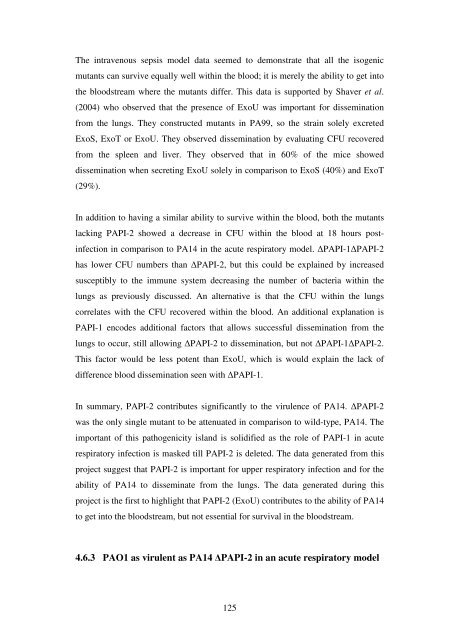5 The role of quorum-sensing in the virulence of Pseudomonas ...
5 The role of quorum-sensing in the virulence of Pseudomonas ...
5 The role of quorum-sensing in the virulence of Pseudomonas ...
Create successful ePaper yourself
Turn your PDF publications into a flip-book with our unique Google optimized e-Paper software.
<strong>The</strong> <strong>in</strong>travenous sepsis model data seemed to demonstrate that all <strong>the</strong> isogenic<br />
mutants can survive equally well with<strong>in</strong> <strong>the</strong> blood; it is merely <strong>the</strong> ability to get <strong>in</strong>to<br />
<strong>the</strong> bloodstream where <strong>the</strong> mutants differ. This data is supported by Shaver et al.<br />
(2004) who observed that <strong>the</strong> presence <strong>of</strong> ExoU was important for dissem<strong>in</strong>ation<br />
from <strong>the</strong> lungs. <strong>The</strong>y constructed mutants <strong>in</strong> PA99, so <strong>the</strong> stra<strong>in</strong> solely excreted<br />
ExoS, ExoT or ExoU. <strong>The</strong>y observed dissem<strong>in</strong>ation by evaluat<strong>in</strong>g CFU recovered<br />
from <strong>the</strong> spleen and liver. <strong>The</strong>y observed that <strong>in</strong> 60% <strong>of</strong> <strong>the</strong> mice showed<br />
dissem<strong>in</strong>ation when secret<strong>in</strong>g ExoU solely <strong>in</strong> comparison to ExoS (40%) and ExoT<br />
(29%).<br />
In addition to hav<strong>in</strong>g a similar ability to survive with<strong>in</strong> <strong>the</strong> blood, both <strong>the</strong> mutants<br />
lack<strong>in</strong>g PAPI-2 showed a decrease <strong>in</strong> CFU with<strong>in</strong> <strong>the</strong> blood at 18 hours post-<br />
<strong>in</strong>fection <strong>in</strong> comparison to PA14 <strong>in</strong> <strong>the</strong> acute respiratory model. ∆PAPI-1∆PAPI-2<br />
has lower CFU numbers than ∆PAPI-2, but this could be expla<strong>in</strong>ed by <strong>in</strong>creased<br />
susceptibly to <strong>the</strong> immune system decreas<strong>in</strong>g <strong>the</strong> number <strong>of</strong> bacteria with<strong>in</strong> <strong>the</strong><br />
lungs as previously discussed. An alternative is that <strong>the</strong> CFU with<strong>in</strong> <strong>the</strong> lungs<br />
correlates with <strong>the</strong> CFU recovered with<strong>in</strong> <strong>the</strong> blood. An additional explanation is<br />
PAPI-1 encodes additional factors that allows successful dissem<strong>in</strong>ation from <strong>the</strong><br />
lungs to occur, still allow<strong>in</strong>g ∆PAPI-2 to dissem<strong>in</strong>ation, but not ∆PAPI-1∆PAPI-2.<br />
This factor would be less potent than ExoU, which is would expla<strong>in</strong> <strong>the</strong> lack <strong>of</strong><br />
difference blood dissem<strong>in</strong>ation seen with ∆PAPI-1.<br />
In summary, PAPI-2 contributes significantly to <strong>the</strong> <strong>virulence</strong> <strong>of</strong> PA14. ∆PAPI-2<br />
was <strong>the</strong> only s<strong>in</strong>gle mutant to be attenuated <strong>in</strong> comparison to wild-type, PA14. <strong>The</strong><br />
important <strong>of</strong> this pathogenicity island is solidified as <strong>the</strong> <strong>role</strong> <strong>of</strong> PAPI-1 <strong>in</strong> acute<br />
respiratory <strong>in</strong>fection is masked till PAPI-2 is deleted. <strong>The</strong> data generated from this<br />
project suggest that PAPI-2 is important for upper respiratory <strong>in</strong>fection and for <strong>the</strong><br />
ability <strong>of</strong> PA14 to dissem<strong>in</strong>ate from <strong>the</strong> lungs. <strong>The</strong> data generated dur<strong>in</strong>g this<br />
project is <strong>the</strong> first to highlight that PAPI-2 (ExoU) contributes to <strong>the</strong> ability <strong>of</strong> PA14<br />
to get <strong>in</strong>to <strong>the</strong> bloodstream, but not essential for survival <strong>in</strong> <strong>the</strong> bloodstream.<br />
4.6.3 PAO1 as virulent as PA14 ∆PAPI-2 <strong>in</strong> an acute respiratory model<br />
125














